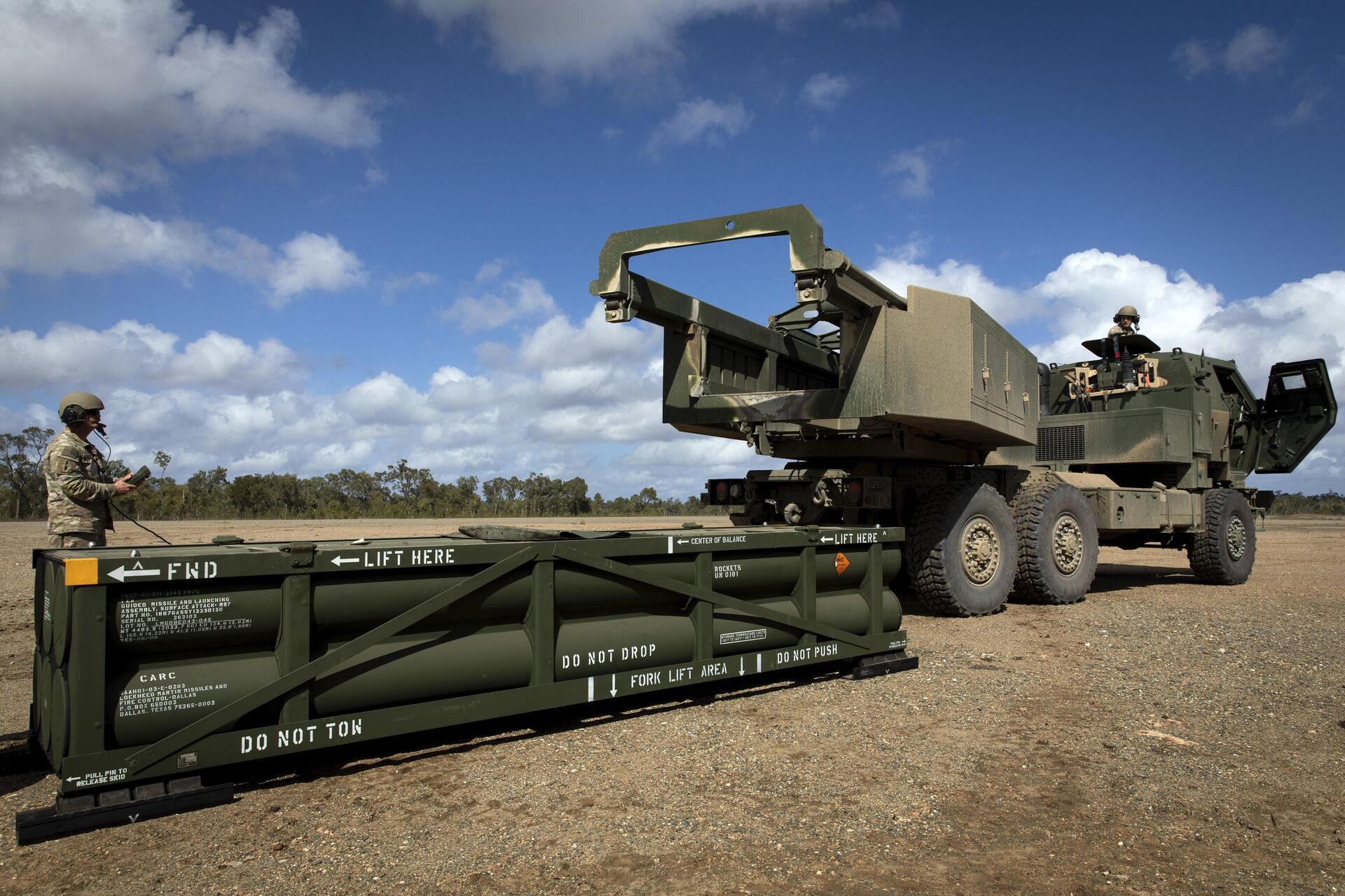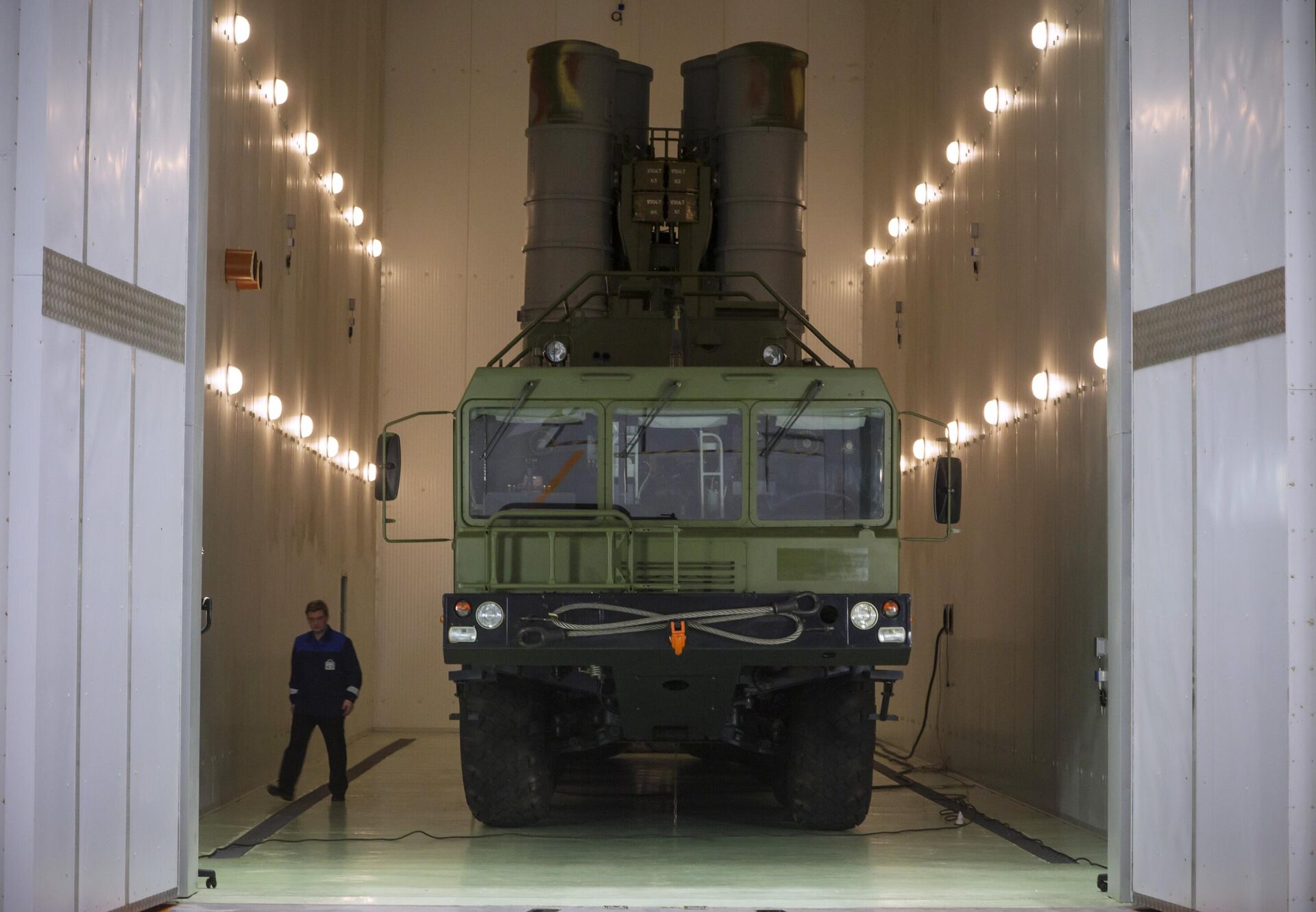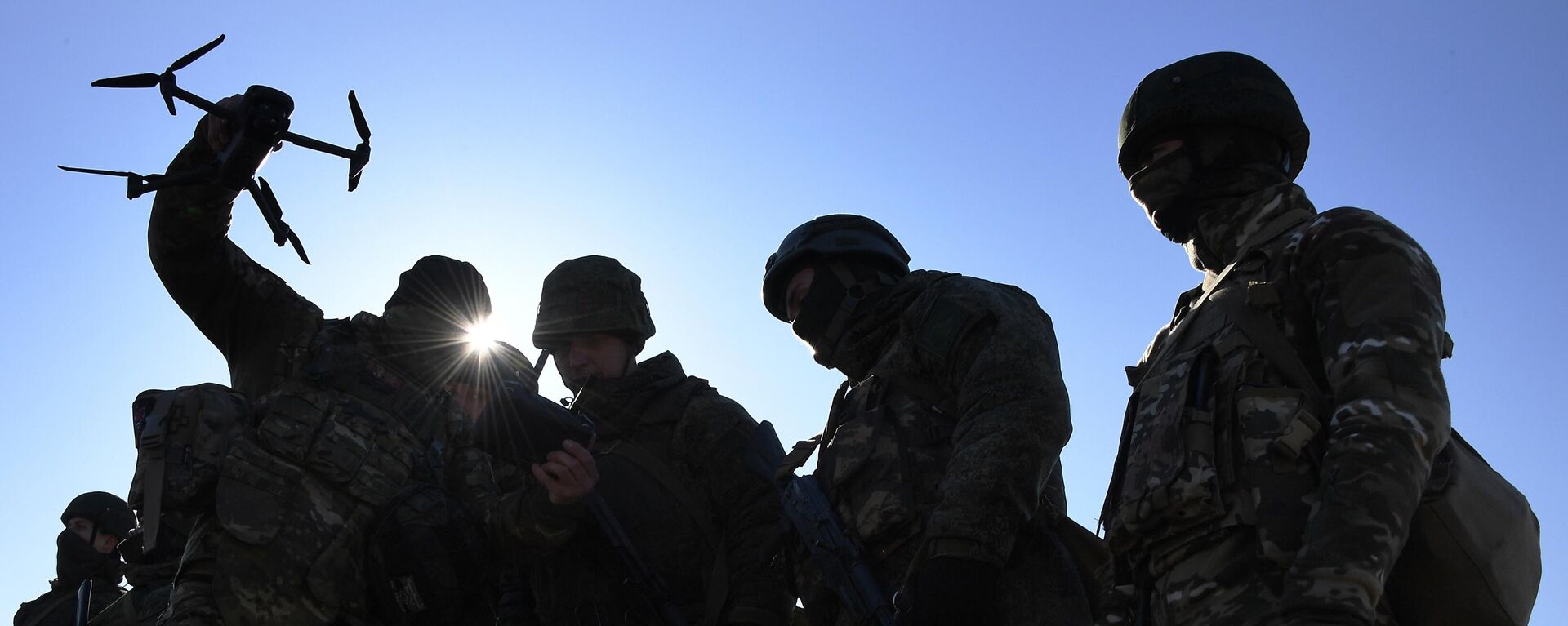In the Face of Western Weapons & Ukrainian War Dance, Russia Remains Resolute

© Sputnik / Stanislav Krasilnikov
/ Subscribe
With the new aid package from the US, Ukraine is trying to keep up with the advances of Russian army. Vijainder K Thakur in his column explains why this aid might actually hurt Ukraine and what is the US aiming to achieve with the new 'care package'.
The US is all set to bolster Ukraine's warfighting capability with a $60.84 billion aid package, of which $13.8 billion will be spent on the purchase of weapons and defense services for Ukraine.
Ukraine would also receive more than $9 billion of economic assistance in the form of “forgivable loans.”
It's likely that the new aid package will include ATACMs with a 300 km range for use with M270 Multiple Launch Rocket System (MLRS).
The supply of ATACMs would be a serious escalation that the US has refrained from for over two years since the start of the SMO. For some unfathomable reason, the US has now thrown caution to the winds!
Understanding Western Imperatives
It's interesting to note that the US aid package, which had remained in limbo since December 2023 with a significant number of Republicans questioning the wisdom of supporting a war effort that is doomed to failure, was magically revived as soon as Ukraine drafted a new law to facilitate increased mobilization - "We will give you the guns, if you give us gun fodder," appears to be the cynical US logic!
The timing and quantum of the US aid package will sustain Ukraine's war effort, but not ensure a Ukrainian victory against Russia.
As such, the aid is aimed at buying time for Ukraine without precipitating a wider NATO - Russia conflict. It's possible that the intent of the aid is to allow Ukraine to negotiate a peace settlement without completely surrendering sovereignty. Also, to forestall capitulation of the AFU (Armed Forces of Ukraine) in the midst of President Biden's re-election campaign.
In the past, the US political leadership has repeatedly stated that it is for the Ukrainians to decide on the terms of a peace agreement that they would like to negotiate with Russia. The US will definitely steer the peace negotiations through the backdoor, but it will not directly get involved in them.
To buy peace at this stage of the war and survive as a sovereign nation, Ukraine will have to cede territory and embrace neutrality, forgoing its ambition of joining NATO. For the US to accept these conditions would be humiliation that would be impossible to sell as victory to its citizens.

In this image provided by the U.S. Army, U.S. Army Sgt. Ian Ketterling, gunner for Alpha Battery, 1st Battalion, 3rd Field Artillery Regiment, 17th Field Artillery Brigade, prepares the crane for loading the Army Tactical Missile System (ATACMS) on to the High Mobility Artillery Rocket System (HIMARS) in Queensland, Australia, July 26, 2023. U.S. officials say Ukraine for the first time has begun using long-range ballistic missiles, called ATACMS, striking a Russian military airfield in Crimea and Russian troops in another occupied area overnight. (Sgt. 1st Class Andrew Dickson/U.S. Army via AP)
© Photo : Sgt. 1st Class Andrew Dickson
Russian Response to the US Aid
Succinctly summing up the Russian viewpoint on the proposed US aid to Ukraine, Kremlin spokesperson, Dmitry Peskov, said the decision "will make the United States of America richer, further ruin Ukraine and result in the deaths of even more Ukrainians."
Russia will understandably feel the pain of the resumed US aid, but it will remain steadfast in pursuing its SMO goals - Demilitarization and Denazification of Ukraine.
Countering US Weapons Through Improved Tactics & Upgraded Weapons
The Ukrainian leadership understands that the influx of additional US weapons and ammunition, including the new wonder weapon ATACMS, will not help AFU reverse the course of the SMO, or halt the relentless advance of Russian forces. After all, two years of US weapons and ammunition supplies, including a litany of wonder weapons, didn't help Ukraine reverse the course of the SMO.
What is possible, however, is that using ATACMS Ukraine could escalate the conflict to an extent where NATO would be tempted to intervene!
The Russian leadership understands the risk but is choosing to counter the additional weapons supply by focusing on improved tactics and the use of weapons upgraded with SMO experience.
While the Ukrainian leadership is performing a war defense before hurling more Ukrainian soldiers into the advancing Russian meat grinder, the Russian military leadership is calmly playing chess, maintaining its defenses intact while curating ever more formidable offensive capabilities.
Russia has a simple strategy - build on what has worked well, address the shortcomings of what hasn't worked well. Russia applies the strategy to both weapon systems as well as tactics. Russia understands Western moves but studiously avoids transactional responses, choosing to remain focused on a strategic victory.
Addressing the Russian Defence Ministry Board Session on April 23, 2024, Russian Defence Minister General of the Army Sergei Shoigu summed up the Russian response saying:
"Russia will continue to improve the composition and structure of the armed forces and increase the production of the most in-demand weapons and military hardware in proportion to the threats posed by the United States and its allies."
"We shall increase the intensity of strikes against logistics centres and storage facilities of the Western armament."
"The Armed Forces of the Russian Federation will continue to carry out the tasks until the special military operation's objectives are fully achieved"
Improving Air Defence Capabilities
The performance of Russian Air Defence (AD) systems during the course of the SMO has been outstanding. Russian AD has protected Russian warfighting capability from the best of cruise and ballistic missiles that the West could provide to Ukraine.
It's not surprising that General Sergei Shoigu told the Russian Defence Ministry Board:
"One of the priorities for the development of the Aerospace Forces is to equip the Air Defence and Anti-Missile Defence forces with promising weapons. Improvement of air defence and anti-aircraft missile defence systems will provide high-quality cover for the most important objects of the command and control system, strategic nuclear forces, and groups of forces."
Shoigu revealed that besides S-400, S-300V4, Buk-M3, and Tor-M2U AD missile systems, Russian forces are set to receive this year "the first samples of a new generation S-500 anti-aircraft missile system in two modifications: long-range anti-aircraft missile systems and anti-missile defence systems."

A S-400 air defense missile system stands in a testing camera during the opening of a testing facility in St. Petersburg, Russia, Friday, Jan. 23, 2015. The S-400 is Russia's latest long-range air defense missile system.
© AP Photo / Dmitry Lovetsky
Building on Pantsir-S1 Success
Russia is set to double the supply of the Pantsir AD missile systems to its forces.
Russia's Pantsir-S1 AD system has proven to be an outstanding performer during the course of the SMO. Russia has continuously tweaked and honed the system for intercepting GMLRS guided rockets, Storm Shadow cruise missiles, and Hammer rocket-assisted glide bombs.
The modernized "Pantsir-SM" can reportedly detect a GMLRS rocket at twice the range of the S1 variant, thanks to the new phased array guidance radar. Its interceptor missile launch speed is 1.2 times faster. As a result, only 3 Pantsir-SM AD missile systems are now required to intercept 24 GMLRS projectiles launched by 2 M270 MLRS launchers.
Other Tech Advances
Besides AD systems, Russia has improved other weapon systems that have performed well during the SMO. Some examples are discussed below:
UMPC Glide Kits
UMPC (Universal Module for Planning and Correction) glide kits, which convert Russia's huge inventory of Soviet-era dumb FAB bombs into smart glide bombs with good standoff range, have proved to be among the most successful weapon systems deployed by Russia in the SMO. The very low RF (Radio frequency) and IR (Infra Red) signature weapons easily elude detection by all advanced Ukrainian AD systems supplied by the West.
After deploying UMPC kits for FAB-500M62 bombs around December 2023, Russia went on to develop similar kits for FAB-250, FAB-1000, FAB-1500, and now even FAB-3000 bombs. The strike accuracy of the UMPC bomb has steadily increased due to hardware and software tweaks; the kits are now resistant to SATNAV jamming.
Russia has now developed a variant of the UMPC kits that feature a small turbojet engine that propels the UMPC kitted bomb much beyond its release point before unfolding the wings for gliding. The kit is referred to as UMPB D-30SN. The new kits will allow RuAF fighters to strike much deeper into Ukrainian territory than glide-only UMPC kitted bombs.
The UMPB D-30SN kit is referred to as interspecific ammunition. A variant of the kits is also being developed for use on Tornado-S 300mm MLRS.
Geran Drones
Russian specialists have steadily made Geran-2 kamikaze drones more lethal since initial deployment in autumn 2022, improving strike accuracy and making the warhead more destructive.
Recently they developed high-explosive fragmentation incendiary and thermobaric warheads of the drone and increased the warhead weight from 50 to 90 kg. Other recent improvements include longer range, increased resilience against GPS jamming, and SIM card-based cellular tracking.
Lancet Drone Performance
Like the Geran long-range kamikaze drones, Russia's very successful Lancet drones have been continuously tweaked for better performance - range, destructive power, and AI-based discrimination.
FPV Drones
Following the start of the SMO, Ukraine gained a lead over Russia in the use of FPV drones. However, observing the destructive potential of kamikaze FPV drones, Russian military leadership, ably supported by the Russian military-industrial base, made up for the slack through mass manufacture and innovative technological variations.
Recent Russian advances in FPV drone technology include the use of thermal imaging, hibernating drones capable of remote launching, decoy drone operator stations.
Counter Drone Technology
Realizing that in contemporary transparent battlegrounds, kamikaze FPV drones can be as effective as artillery, Russia has been continuously developing and refining its electronic warfare (EW) capability against FPV drones.
The Russian company Volnorez has developed an electronic reconnaissance (ER) and EW vehicle based on the Triton amphibious vehicle. The extended Breakwater complex will be installed on the Triton, which will conduct not only radio jamming but also electronic reconnaissance
The Breakwater system has the form factor of a small-sized (length - 484 mm, weight - 13 kilograms) cone, which is installed with magnetic Velcro on any military (tanks, armored personnel carriers, boats, etc.) and civilian equipment.
The key feature of the Breakwater complex is its modularity. “Breakwater” contains those frequencies that are necessary to suppress enemy FPV drones on a specific section of the front in real-time. Breakwater operators install new “cones” on their vehicles, thereby modifying their electronic warfare system to meet specific current threats.
Glide Capable MLRS rockets and bombs
Russia has reportedly deployed Glide-capable 300 mm Tornado-S MLRS with extended range, similar to the US GLSDB (Ground Launched Small Diameter Bomb). A variant of the shell can also be launched by aircraft.
Refining Tactics
Besides improving its weapons, Russia is also refining its tactics to negate the effectiveness of Western supplied weapons.
A recently released RuMoD video showed Su-34 using toss bombing to negate the increased range of the US supplied Patriot missiles.
Past RuMoD videos invariably showed Su-34 bombers dropping their FAB UMPC bombs from medium altitudes and level flight.
Medium altitude, high-speed bomb release allowed the Su-34s to maximum standoff range while staying outside the engagement envelope of Ukrainian AD systems. When Ukraine moved its Patriot batteries closer to the battlefront, rather than drop bombs from deeper inside Russian territory, and thereby reduce the depth of attack, Russian pilots switched to a hi-lo-hi profile of attack.
High-speed terrain-hugging approach to the bomb release zone completely precludes radar detection and long-range AD missile engagement. Tossing at high speed in a steep climb maximizes the range of the bomb.
It's likely that the switch to toss bombing required significant tweaks to the bomb release algorithms.
Conclusion
In the face of Western weapons supplies and the Ukrainian war dance, Russian leaders appear resolute, confident in the support of the Russian people and the excellence of the Russian military-industrial base.
The Russian approach to the resumed US weapon supply was consummately stated by General Shoigu in his recent address:
"The enterprises of the Russian defence industry have increased their capabilities. The Russian Armed Forces have significantly enhanced the combat potential. It is proved by the situation in the special military operation zone."


